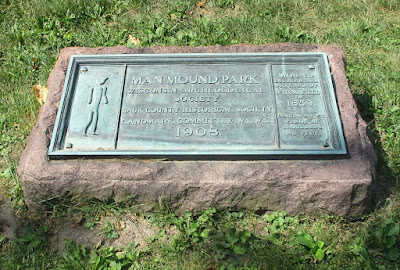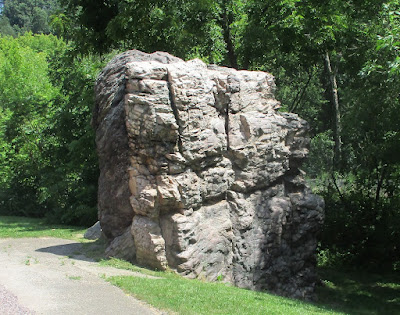Today I visited two places near my undisclosed location in Wisconsin, one of which was included on my archaeological tour in 2014. Northeast of Baraboo, WI is Man Mound, an earthwork built by Native Americans some time between 750 and 1200 AD. The mound is now the main feature of a park having the same name. It was also designated as a national historic landmark, which happened after my first visit. The park has a small gravel parking lot, which was not yet present nine years ago. I'm sure that some people on Man Mound Road did not appreciate having it partially blocked by a tour bus.
If you drive down Man Mound Road today, you'll see the Man Mound sign.
Here's a shot of the "head" and "chest" of the mound, which is covered with tall grass and other plants. The small sign says to keep off the mound.
Near the mound is this low-lying plaque.
I took this next shot from near the "head" of the mound, which was in shade, looking back toward the road, which like the rest of the mound was in sunlight. You can also see two electrical wires.
The green areas on the road show where the mound's lower "legs" used to be. Nine years ago, these features were painted (or maybe plastered) white. See my post from June 2014 to see the comparison. Unlike then, there are no longer any local bovine residents in the pen across the road.
My last shot of the mound from from the road between the "legs" toward the "head". Unlike nine years ago, none of the between parts of the mound are mowed.
To learn more about Man Mound, besides the links above, go to Hocak Worak, Only In Your State, Atlas Obscura, Wisconsinology and Sauk County Historical Society.
After leaving Man Mound, I drove west from Baraboo on Wisconsin Route 136 to the village of Rock Springs and continued to an actual spring beside the road. I didn't take any pictures there, but filled a small plastic bottle with fresh spring water. About 2,200 feet further up the road is Van Hise Rock, named after University of Wisconsin geology professor and President Charles Van Hise. Just off the road is this sign, with two large rocks on either side.
Here's the south side of the Van Hise Rock. Due to the mowed area toward the right, it appears that you're allowed to step down behind it, but don't go too far or you'll be trespassing on some railroad tracks.
On the north side of the man rock is a plaque and a stack of several smaller (but still pretty large) rocks.
For more information on the Van Hise Rock, go to Updates from the Paleontology Lab, AGU Blogosphere, and Isthmus.









No comments:
Post a Comment